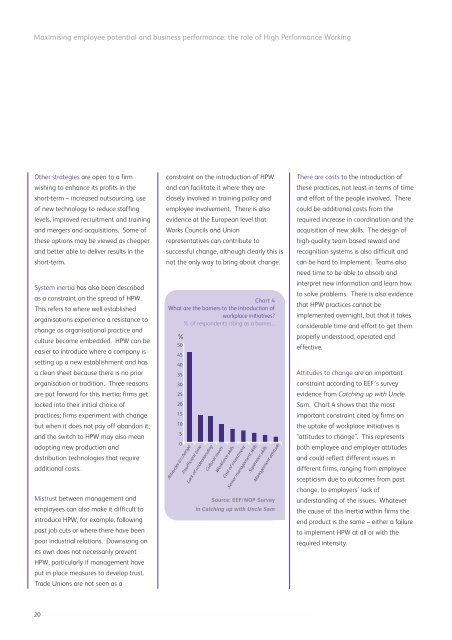About EEF - CIPD
About EEF - CIPD
About EEF - CIPD
You also want an ePaper? Increase the reach of your titles
YUMPU automatically turns print PDFs into web optimized ePapers that Google loves.
Maximising employee potential and business performance: the role of High Performance WorkingOther strategies are open to a firmwishing to enhance its profits in theshort-term – increased outsourcing, useof new technology to reduce staffinglevels, improved recruitment and trainingand mergers and acquisitions. Some ofthese options may be viewed as cheaperand better able to deliver results in theshort-term.System inertia has also been describedas a constraint on the spread of HPW.This refers to where well establishedorganisations experience a resistance tochange as organisational practice andculture become embedded. HPW can beeasier to introduce where a company issetting up a new establishment and hasa clean sheet because there is no priororganisation or tradition. Three reasonsare put forward for this inertia: firms getlocked into their initial choice ofpractices; firms experiment with changebut when it does not pay off abandon it;and the switch to HPW may also meanadopting new production anddistribution technologies that requireadditional costs.Mistrust between management andemployees can also make it difficult tointroduce HPW, for example, followingpast job cuts or where there have beenpoor industrial relations. Downsizing onits own does not necessarily preventHPW, particularly if management haveput in place measures to develop trust.Trade Unions are not seen as aconstraint on the introduction of HPWand can facilitate it where they areclosely involved in training policy andemployee involvement. There is alsoevidence at the European level thatWorks Councils and Unionrepresentatives can contribute tosuccessful change, although clearly this isnot the only way to bring about change.Chart 4What are the barriers to the introduction ofworkplace initiatives?% of respondents citing as a barrier...%50454035302520Attitudes to changeInsufficient timeLack of understandingCultural issuesWorkforce skillsCost of investmentSenior management skillsSupervisor skillsManagement attitude151050Source: <strong>EEF</strong>/NOP Surveyin Catching up with Uncle SamThere are costs to the introduction ofthese practices, not least in terms of timeand effort of the people involved. Therecould be additional costs from therequired increase in coordination and theacquisition of new skills. The design ofhigh-quality team based reward andrecognition systems is also difficult andcan be hard to implement. Teams alsoneed time to be able to absorb andinterpret new information and learn howto solve problems. There is also evidencethat HPW practices cannot beimplemented overnight, but that it takesconsiderable time and effort to get themproperly understood, operated andeffective.Attitudes to change are an importantconstraint according to <strong>EEF</strong>’s surveyevidence from Catching up with UncleSam. Chart 4 shows that the mostimportant constraint cited by firms onthe uptake of workplace initiatives is“attitudes to change”. This representsboth employee and employer attitudesand could reflect different issues indifferent firms, ranging from employeescepticism due to outcomes from pastchange, to employers’ lack ofunderstanding of the issues. Whateverthe cause of this inertia within firms theend product is the same – either a failureto implement HPW at all or with therequired intensity.20
















